
by Igor Polkovnikov (AKA Igor Polk). Started 2014-02-22, this version 2014-02-27, www.virtuar.com/triz/2014/flows.htm



































































An intuitive idea of a flow between systems is formalized to include changes in distance, area and volume. It is possible that the generalized "flows" participate in 2/3 of TRIZ problem formulations and solutions. A table of problems taken from the Altshuller's book "Creativity as an exact science" shows participating flows and their functions. It is proposed that the notion of abstract flows may help in general definition of interaction and expand TRIZ application to new areas.
Keywords: TRIZ, flow, system, interaction, automatic problem solving, flow of distance, flow of area, flow of volume, boundary.
Despite any definition one gives to a word "system", if there is a system, there is surrounding of this system. It may be another system, systems, or the "environment". If there is a system and surrounding, there is a boundary between them.
Contrary to an abstract boundary which is a line, surface, etc., i.e. a product of human's mental considerations, a boundary between a system and its surrounding is real. And again, contrary to abstract boundaries a real boundary is not precise. It has some vagueness in its existence. In TRIZ terms, it combines, may be on a micro- or a micro-micro- level properties of the system and its immediate surrounding. As such it may attract attention of TRIZ developers as an area combining contradictory properties. For now, let us take that a boundary is abstract, ideal, ignore the effects in the boundary.
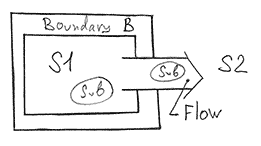 When subsystems Subs of a system S1 pass the boundary B it is called a flow. From where Subs are coming is irrelevant for now. They can be passed from internals of the system or be formed right on the boundary. The concept of flow implies the abstract movement and time. Regarding where the flow goes, there are three cases possible. First, when Subs pass to the environment. Second, when Subs pass to another system. Both of them will be called S2. Or third, when Subs become a part of system S1 right after passing the boundary B.
When subsystems Subs of a system S1 pass the boundary B it is called a flow. From where Subs are coming is irrelevant for now. They can be passed from internals of the system or be formed right on the boundary. The concept of flow implies the abstract movement and time. Regarding where the flow goes, there are three cases possible. First, when Subs pass to the environment. Second, when Subs pass to another system. Both of them will be called S2. Or third, when Subs become a part of system S1 right after passing the boundary B.
Systems posses a property of stability. It relates to flows too. Water flow is a system itself, traffic flow is a system on a road.
There should be a mechanism providing the flow. Speaking generally, borrowing from physics, it can be called a difference of potentials or dP. Subs being responsive to a certain potential PS1 are moving in the direction of lower potential PS2. Another constraint of flow existence is the passing property of the boundary, is it able to pass the flow.
A boundary may have two regions. One may be able to pass Subs, BP. Another one, BI, not. It insulates S1 from S2 in relation to the Subs flow.
Subs are systems themselves. They may possess other subsystems or/and properties. Let us call them all E. In particularly, an E may be a subject of dP, move over the B and curry the whole Sub with it. Example, the charged dust particles moving in electrical field. On the other hand, in this case, instead of talking about a flow of Subs, one may abstract, ignore Subs, and talk about a flow of E.
A system issuing a flow of Subs directly affects the environment or the neighboring system by injecting Subs into it.
If there is a system S1 and a system S2 ( it may be an environment, for briefness I will use "system" from now for both), and there is a third system SC which conducts the flow of Subs from S1 to S2, the SC is called a conductor. It conducts the flow from S1 to S2. The conductor may have three regions of its boundary. First with S1, second with S2, and the third one with some other system, systems, or environment. The third one may be absent. In a case when the conductor has insulation with the third systems, it is called a pipe SP.
Within a single system, there can be a field of potentials inducing a field of flows. In relation to flows, systems posses such properties like capacity, resistance.
Here are some examples of basic physical flows:
| Flow | Potential | E | |
| Flow of liquids | Pressure | Particles of liquid with mass | |
| Flow of mass | Gravity | Everything which has mass | |
| Electrical flow | Electric potential | Electrical charge, electrons, protons | |
| Heat | Temperature | Heat | |
| Flux of momentum | Velocity | Momentum | |
| Diffusion | Concentration | Molecules |
If many Subs are moving, it is a flow. When only one Sub is moving it is a flow too. For example, two boys through a ball at each other.
When two flows exist or may exist, it is called a contra flow. The actual flow may be absent because a system is in rest, but there is a cause for both flows. The flows balance each other.
Example 1. If two vessels with the same level of liquid in gravitational field are interconnected with a pipe, there is no flow through the pipe, or one can say there is a contra flow. Liquids from one vessel diffuse to another, but this is not a flow caused by gravity. If one vessel is moved, the flow caused by gravity will appear in one direction or another.
Example 2. Let a weight be put on a spring in gravitational field. Movement of the weight is a flow. In some time the system will come to a balance when the spring is compressed and there is no movement. The flow of the weight down initiated by the gravity is balanced with the flow of weight movement up initiated by the spring. If the gravitational field is suddenly switched off, the spring will push the weight up.
Contra flows may not necessary balance each other. When a contra flow exists, one flow may be compensated by another flow partially or completely. Also, contra flows are not the same as two different flows between S1 to S2. In the case with two different flows as well as with contra flows, one might say that the systems interact.
Example 1. Let us look at a small water flow in desert. With the rain, water comes out of a small pond and starts flowing down the dry stream bed. At the front of it, a boundary between water and dry bed exist. With every drop of water flowing into it from upstream, the water spreads down. Water flows out of the stream, but it stays as a part of the water stream.
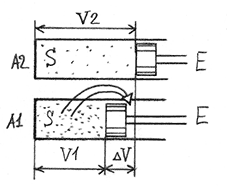
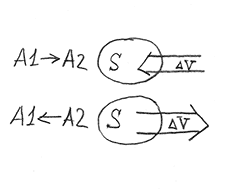 Example 2. The gas confined in a cylinder S sealed with a movable piston is heated. The gas expands, the piston moves. The gas obtained a larger volume as if there was a flow of volume from the environment E into the gas. If the piston is pressed, decreasing the volume of the gas, one might say, there is a flow if volume from the gas to the environment.
Example 2. The gas confined in a cylinder S sealed with a movable piston is heated. The gas expands, the piston moves. The gas obtained a larger volume as if there was a flow of volume from the environment E into the gas. If the piston is pressed, decreasing the volume of the gas, one might say, there is a flow if volume from the gas to the environment.
Here we came to the abstract flow of volume. A Sub here is an elementary volume of gas, but one may say there is a flow of volume.
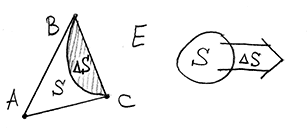 Similarly, in two dimensions, one may say that there is a flow of area, if, for example, in a triangle ABC a side BC inflects. A flow of dS from S to E.
Similarly, in two dimensions, one may say that there is a flow of area, if, for example, in a triangle ABC a side BC inflects. A flow of dS from S to E.
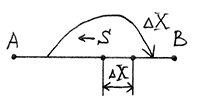 Similarly, in one dimension, one may say that there is a flow of distance. For example, here, if a point S is moving along a line BA, there is a flow of distance dX from the segment AS to SB.
Similarly, in one dimension, one may say that there is a flow of distance. For example, here, if a point S is moving along a line BA, there is a flow of distance dX from the segment AS to SB.
Flow Functions
|
- Generation |
|
- Reflection |
|
- Effects of gradient in flows |
System Effects
|
- Charge-Discharge (when the second system is large); |
|
- When one system is captured and carried by another one; |
Transformation of Flows:
Physical Effects
|
1. Potential - Elementary property (electric potential-electical charge); |
Hypothesis:
All actions and interactions are flows
|
Conclusion 1) Flows belong to the domain of Systems Theory (TRIZ). |
|
Everything flows, nothing stays still Heraclitis of Ephesus (535-475 BC) |
|
Web reference to the presentation www.virtuar.com/triz In particularly, |
|
Potential and "Charge"
|
How often flows are encountered in inventive problems? To make a rough estimate I took the famous Altshuller's book and went through all problems given there. Out of 143 problems, in 100 problems flows where part of the problem formulation or a solution. In 43 problems I was not able to find references to flows.
Here is the table where I wrote a problem name, what flows are there, and what functions related to flows are in those problems. On the left, for convenience, there are page numbers of the two editions of Altshuller's book, in Russian and in English. The Russian edition is "Творчество как точная наука", Г.С.Альтшуллер, Москва, "Советское радио", 1979. The English edition is "Creativity as an exact science", by Al'tshuller, G.S., Gordon and Breach Science Publishers, 1984, ISBN 0-677-21230-5.
| Page (rus) |
Page (eng) |
Name | Flow of | Functions |
| 17 | Problem 1, conveying liquid oxygen into the furnace | liquid oxygen, heat | providing, insulation | |
| 18 | Problem 2, lighting of welding place | light | reflection | |
| 21 | Problem 3, wood and bark chips | - | ||
| 29 | Problem 4, polishing lenses | water | replace, generate | |
| 45 | Problem 5, killing Bolton | bullet from a gun | indication of past flow | |
| 46 | Problem 6, plough testing ground | plough through the ground | resistance, conductivity | |
| 46 | Problem 7, measuring depth of river from aircraft | water | geometrical | |
| 47 | Problem 8, measure an abrasive disk wear | area of circle | geometrical | |
| 48 | Problem 9, find leaks in refrigerators | liquid | indication now | |
| 48 | Problem 10, measure degree of polymer hardness | ? | ||
| 48 | Problem 11, intensity of movement in pseudo-liquification | chaotic solid particles | measure waves | |
| 48 | Problem 12, extractable wedge | heat | create, enable phase transitions in the conductor | |
| 59 | Problem 13, filtering air from dust | air and dust | filtration | |
| 64 | Problem 14, paper electrifying | paper along plexiglas | insulation | |
| 41 | 67 | Problem 15, drilling shaft jamming | deformation of solid body | effect accompanying the flow ( de-magnetization) |
| 42 | 69 | Problem 16, floating solid moving in magnetic liquid | solid in 2D liquid | enhancing controllability |
| 42 | 70 | Problem 17, (Ac 304356) pneumoflow of solid balls | solid balls | protecting the pipe (conductor) |
| 43 | 70 | Problem 18, close-fitting testing with paint | - | |
| 43 | 71 | Problem 19, mixing | rotating flow of something | generate |
| 43 | 71 | Problem 20, orientation of micro diamonds | - | |
| 43 | 71 | Problem 21, cavitation on hydrofoils | hydrofoils through water | effect accompanying the flow (generation of "bubbles" in the flow) |
| 43 | 71 | Problem 22, measure stress on reinforcement | micro deformation | measure |
| 45 | 76 | Problem 23, pre-stressed reinforced concrete | deformation, heat | generate |
| 52 | 89 | A "weevil" problem ( dolgonosik ). It seems does not have a flow, but Altshuller used an analogy with "temperature of a single droplet if it is raining and one can gather a glassful of rainwater", or with flow of water... Glass is a capacity. | particles | capacity |
| - | 287 | Problem 24, polishing spoons | chaotic particles | effect accompanying the flow (polishing) |
| - | 287 | Problem 25, radio-telescope | radio waves from stars, lightning, electrical current in conductors | shielding |
| 57 | 98 | Problem 26, about heated catalyst | - | |
| 58 | 100 | Problem 27, inclination gauge | - | |
| 58 | 101 | Problem 28, checking cones | - | |
| 58 | 102 | Problem 29, animations | - | |
| 59 | 102 | Problem 30, greenhouse ( transformation of temperature into linear movement) | - | |
| 59 | 103 | Problem 31, metal cubes and aggressive liquid | - | |
| 59 | 103 | Problem 32, a moment of boiling | find a flow | detection |
| 66 | 117 | Problem 33, a speed boat | - | |
| 75 | 134 | Problem 34 cylinder painting | aerosol | |
| 78 | 139 | Problem 35, ions | ions | reflection |
| 81 | 144 | Problem 36, pulp in a pipeline | water-solid mix | |
| 81 | 145 | Problem 37, sealing ampoules | heat | insulation |
| 81 | 146 | Problem 38, rate of acceleration | - | |
| 81 | 146 | Problem 39, chemical deposition | atoms | termination of the flow, activation |
| 82 | 147 | Problem 40, measure density with Archimedean force | solid in water | controlling with potential |
| 82 | 148 | Problem 41, alcohol in tank | alcohol | extracting from flow |
| 84 | 151 | Ex. to Principle 1, | - | |
| 84 | 152 | Ex. to Principle 2, removal | noise, vibrations | insulation |
| 84 | 152 | Ex. to Principle 3, local quality | liquid, drops | insulation, making a pipe |
| 85 | Ex. to Principle 4, | - | ||
| 85 | Ex. to Principle 5, | - | ||
| 85 | Ex. to Principle 6, | - | ||
| 85 | Ex. to Principle 7, | - | ||
| 85 | 154 | Ex. to Principle 8, counterweight | air, wing | perpendicular flow |
| 86 | 155 | Ex. to Principle 9, preliminary counter-action | vibrations | controlling with potential, suppression |
| 86 | Ex. to Principle 10, | the same like Problem 41 | ||
| 86 | Ex 1. to Principle 11, cushion | chemicals diffusion | boundary effect | |
| 86 | 156 | Ex 2. to Principle 11, tree branch nutrition | chemicals in water | creating capacity |
| 87 | 156 | Ex. to Principle 12, equipotentiality | material bodies | flow equipotentially (in crossing direction to potential gradient) |
| 87 | 156 | Ex. to Principle 13, | - | |
| 87 | 157 | Ex. to Principle 14, | - | |
| 87 | 157 | Ex. to Principle 15, strip electrode | metal strip with width varying | effects of uneven flow |
| 88 | Ex. to Principle 16, | the same like Problem 34 | ||
| 88 | Ex. to Principle 17, | - | ||
| 88 | 159 | Ex. to Principle 18, cutting timber without a saw | solid in solid | decreasing resistance |
| 89 | 159 | Ex. to Principle 19, welding and measuring thermo-electric motive force (emf) | electrical current | effects on junctions |
| 89 | 160 | Ex. to Principle 20, drilling | solid in solid | flow and contra-flow, constant flow |
| 89 | 160 | Ex. to Principle 21, veneer heating | heat | impulse flow |
| 89 | 160 | Ex. to Principle 22, restore flowing of loose | dry disperse particles | generation of flowing particles |
| 90 | 161 | Ex. to Principle 23, feedback principle | heat, solid particles, gas | |
| 90 | 161 | Ex. to Principle 24, tension measurement device calibration | deformation | interruption |
| 90 | 161 | Ex. to Principle 25, welding rod feed | metal wire | generation |
| 90 | 162 | Ex. to Principle 26, | - | |
| 91 | 162 | Ex. to Principle 27, mouse-trap | a mouse | "Maxwell's daemon" flow generator |
| 91 | 162 | Ex. to Principle 28, metallization of plastic surface | "diffusion" | intensification |
| 91 | 163 | Ex. 1 to Principle 29, "air bag" on a drive shaft | momentum | turning on-off or switching |
| 92 | 164 | Ex. to Principle 30, gas-concrete | gas | insulation, generation |
| 92 | 165 | Ex. to Principle 31, porous steel machine elements | head, liquid | a flow intensified by another flow |
| 92 | 165 | Ex. to Principle 32, transparent bandage | liquid, light | filter |
| 93 | 165 | Ex. to Principle 33, cast mould | deformation | contraflow to eliminate the flow |
| 93 | 166 | Ex. to Principle 34, melting light-conductor | light, solid | flow of flow conductor |
| 93 | 166 | Ex. to Principle 35, breaking zone of landing stripes | aircraft | increasing resistance, stopping |
| 93 | 166 | Ex. to Principle 36, sealing with cold metal | heat, deformation | |
| 93 | 167 | Ex. to Principle 37, greenhouse | head, deformation, movement | transformation of flows |
| 94 | 167 | Ex. to Principle 38, chemical gas transporting reaction | molecules | increase stopping |
| 94 | 168 | Ex. to Principle 39, cotton transportation | cotton, gas | prevention of the effects |
| 94 | 168 | Ex. to Principle 40, cooling | heat | stabilization |
| 97 | 172 | Problem 42, paraffin deposits | oil, paraffin | deposition |
| 97 | 172 | Problem 43, sprinkler machine | water, momentum, weight | |
| 97 | 173 | Problem 44, vacuum bag | - | |
| 97 | 173 | Problem 45, Mobius tape | - | |
| 101 | 182 | Problem 46, pressed ball | ball | impulse generation |
| 103 | 184 | Ac 259949, | - | |
| 103 | 185 | Ac 282342, power plant circle | heat, two reacting chemicals | circle with two different flows |
| 103 | 185 | Ac 152842 | - | |
| 103 | 185 | Ac 247159 | - | |
| 104 | 186 | Ac 465502 | - | |
| 105 | 188 | Ac 247064, electromagnetic pump as a ship propulsion engine | ionized water | propulsion |
| 105 | 188 | Ac 489862 - next, micro movement | displacement | |
| 107 | 193 | Ac 518591 Maltese cross mechanism magnetization | - | |
| 107 | 193 | Problem 47, improve a spring | - | |
| 108 | 194 | Problem 48, ferrite warmers | - | |
| 108 | 195 | Ac 452055, effect "Hopkinson Peak" | heat, electromagnetic energy | stabilization of one flow to achieve the maximum of another. |
| 109 | 196 | Ac 504944, effect similar to Barkhausen effect | deformation, electromagnetic energy | (force is potential) |
| Barkhausen effect | heat, electromagnetic, orientation of domains | transformation of continuous flows into discrete | ||
| 110 | 198 | Problem 49, measure high voltages | electromagnetic | |
| 111 | 200 | Problem 50, tomato sorting | There are ;) | |
| 111 | 201 | Problem 51, weigh railcars with scrap metal | - | |
| 112 | 202 | Problem 52, precise control of the flow between vessels | gas, displacement | perpendicular flows, flow control: "valve" |
| 112 | 202 | Problem 53, heat centrifuge | angle of rotation | perpendicular flows, effect on a flow |
| 112 | 203 | Problem 54, brilliant cut in pieces | - | |
| 112 | 204 | Problem 55, stabilizing transmission | angle of rotation | |
| 118 | 214 | a problem about a drum furnace | cement, heat | |
| 129 | 234 | Standard 1, Ac 415516, diamond changes with heat | heat, light, displacement | |
| 129 | 234 | Standard 2, Ac 350219, yellow, blue, green.. | light of different color | multiple flows, combination of flows |
| 129 | 235 | Standard 3, Ac 412062, protection of hydrofoils | water | deposition, "inversed pipe"( solid inside the flow) |
| 129 | 235 | Standard 4, magnetism | magnetic liquid, magnets | controllability, change of flow-not flow |
| 130 | 236 | Standard 5, system->subsystem | - | |
| 130 | 236 | Standard 6, | - | |
| 130 | 236 | Standard 7, combination of mutually exclusive actions | any | flows in pauses of each other |
| 130 | 237 | Standard 8, trigger and measure vibrations (any parameters of response) | any, vibrations, waves | |
| 132 | 241 | Problem 56, pack fruits | peaches | |
| 133 | 242 | Application 1 of morphological analysis | liquid, magnetic field, electrical current | perpendicular flows |
| 135 | 245 | Ac 499912, non-die drawing of steel wire through a ferromagnetic mass | steel wire, deformation | narrowing the flow |
| 135 | 246 | Ac 165651, rotating magnetic field - rotating part | metal | inversion of the pair system-flow |
| 135 | 247 | Ac 397289, | - | |
| 136 | 247 | Problem 57, | - | |
| 136 | 248 | Problem 58, obtain polymer miniscule spheres | compressed air, liquid polymer, solid spheres | process within a flow |
| 136 | 249 | Problem 59, are the lids tight? | air in liquid | detection of conductors |
| 137 | 249 | Problem 60 | - | |
| 137 | 250 | Problem about heat-resistant insulation of a converter | - | |
| 138 | 251 | Problem about hydraulic extrusion | wave of pressure | |
| 139 | 254 | Ac 270209, swamping | concrete gravel | |
| 139 | 254 | Problem 61, metal-plating lubricants | molecules | decomposition, deposition |
| 141 | 258 | Problem with Antonov's aircraft | aircraft-air | stabilization |
| 142 | 260 | Problem with"armed" machine | flows through | measuring |
| 149 | 275 | Problem with coiling wires | metal wire, liquid metal | transforming |
| 150 | 277 | Paradox of traveling of hydrogen atoms off metal | molecules, hydrogen | forming |
| 151 | 279 | Problem 62, turn rubber on a lathe | - | |
| 152 | 280 | Problem 63, Toms effect | liquid | decrease friction |
| 152 | 280 | Problem 64, measure critical level | sound | indication, a flow through everything |
| 152 | 281 | Problem 65, melting beryllium | - | |
| 152 | 282 | Problem 66, breaking-in of engines | there are.. | |
| 153 | 283 | Problem 67, | - | |
| 153 | 283 | Problem 68, | - | |
| 153 | 284 | Problem 69, soldering capillaries | hot solder | |
| 153 | 284 | Problem 70, | - |
With the formalization proposed, it is assumable that the majority of TRIZ problems have, operate with the "flows". As one can see from the right table column, there are numerous functions, situations associated with flows. All of them are systematic, they are general and applicable to any flow. Such properties of the "flow" system domain as "potential", "capacity", "conductivity" are not researched in general TRIZ, but they are abundant in scientific research and technology. The inventive problems might be restated in terms of flows and all phenomena related to them, which might lead to a better solution path. Bringing "flows" into TRIZ may expand its application, and may enable automatic solution of inventive problems. In future, the proposed formalization unifying "movements" in Euclidean space with flows may support "mathematization" of TRIZ. The proposed formalization is an idea, but it seems to have merits for more research.